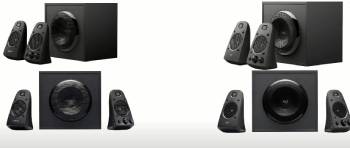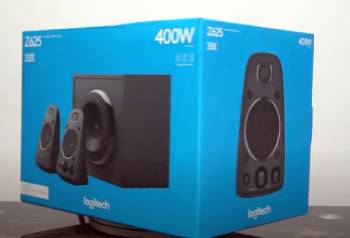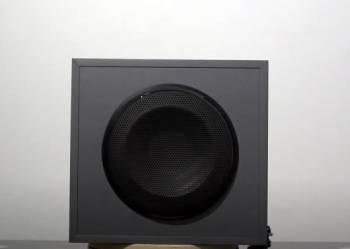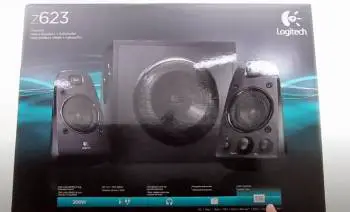I’ve been chasing that perfect audio punch for years now, bouncing between setups for gaming marathons, movie nights, and late-night playlists.
That’s why I’m pitting the Logitech Z623 against the Z625 here—two beasts in the 2.1 speaker world, both THX certified and packing 200 watts RMS.
My goal? Break it down so you can pick the one that amps up your space without the guesswork.
Whether you’re upgrading your desk or wiring a living room, let’s see which delivers the boom you crave.
Logitech Z623 Vs. Logitech Z625
| Feature | Logitech Z623 | Logitech Z625 |
| Release Year | 2010 | 2016 |
| Power Output (RMS/Peak) | 200W / 400W | 200W / 400W |
| THX Certification | Yes | Yes |
| Inputs | 3.5mm, RCA (stereo) | 3.5mm, RCA (stereo), Optical |
| Subwoofer Size | 7 inches | 7 inches |
| Satellite Speakers | 2 x 3 inches | 2 x 3 inches |
| Frequency Response | 35Hz – 20kHz | 35Hz – 20kHz |
| Dimensions (Subwoofer) | 11.8 x 11.2 x 13.9 inches | 11.7 x 11.8 x 14.2 inches |
| Weight (Total) | 19.4 lbs | 19.4 lbs |
| Approximate Price (2025) | $130 – $150 | $140 – $160 |
| Best For | Budget setups, basic connectivity | Modern devices, optical audio sources |
A Quick Look at the Logitech Z623

I still remember unboxing the Z623 back in 2013, that cardboard scent mixing with the promise of room-shaking bass.
This 2.1 system hit the scene in 2010, and it quickly became a go-to for folks wanting THX-certified sound without breaking the bank.
At its core, you’ve got two satellite speakers, each with 3-inch drivers, paired with a 7-inch down-firing subwoofer that promises to rattle your windows.
The power? A solid 200 watts RMS, peaking at 400 watts, which means it handles everything from subtle dialogue to explosive action scenes.
Setup was a breeze for me—plug in the 3.5mm or RCA cables, tweak the subwoofer dial on the back, and you’re off.
No fancy apps or remotes here; it’s all analog control with a wired pod for volume and bass adjustments.
In my early days with it, hooked to a desktop PC, the sound filled my small apartment effortlessly.
Movies like Inception felt immersive, with the sub thumping on those dream-layer drops.
For music, it leaned heavy on the lows—think hip-hop tracks where the beat dominates.
But gaming? Oh yeah, titles like Battlefield 4 had me flinching at every grenade.
The build feels sturdy, with MDF enclosures on the satellites to cut vibrations, and the sub’s got that industrial vibe with its black finish.
Weight-wise, it’s no feather at 19.4 pounds total, but that solidity translates to less rattle during playback.
One thing I noticed right away: the inputs are straightforward, perfect for older consoles or TVs without digital outs.
Switching sources meant yanking cables, though, which got old fast in a multi-device home.
Still, for under $150 even today, it’s a value king if you’re not chasing the latest bells.
I ran it through countless playlists, and while the highs could get a tad sharp on treble-heavy tracks, the overall punch kept me coming back.
Compared to tinny laptop speakers, this was a revelation—clear mids for vocals, and bass that you feel in your chest.
If you’re wiring up a budget rig, the Z623 doesn’t disappoint on raw delivery.
Exploring the Logitech Z625
Fast forward to 2016, and Logitech drops the Z625, essentially giving the Z623 a glow-up without reinventing the wheel.
I snagged one during a Black Friday sale, curious if the tweaks would justify the switch.
Right out of the box, the similarities hit: same 200-watt RMS punch, THX seal of approval, and that familiar 2.1 layout with 3-inch satellites and a 7-inch sub.
But here’s where it steps up—the addition of an optical input, which opened doors to cleaner digital audio from soundbars, Blu-ray players, or even PS5s.
No more analog hiss; it’s like upgrading from vinyl scratches to streaming clarity.
The control pod mirrors the Z623’s, with easy bass and volume knobs, but now you’ve got three input switches for seamless toggling.
In my living room test, connected via optical to a Roku, the dialogue in The Mandalorian stayed crisp without drowning in effects.
Bass response? Slightly tighter than the Z623’s, less boom and more definition—perfect for electronic tracks where precision matters.
Gaming sessions on my Xbox Series X turned epic; the sub synced explosions in Halo Infinite without muddling footsteps.
Build quality holds the line, with those same vibration-dampening cabinets, though the sub feels a hair more refined in its porting.
At around 19.4 pounds, it’s portable enough for desk hops but stays put during blasts.
I appreciated the RCA and 3.5mm backups for legacy gear, like my old MP3 player nostalgia kicks.
Power-wise, it matches the Z623 watt-for-watt, but in blind tests with friends, the Z625 edged out on clarity at high volumes.
Movies benefited too—subtle scores in sci-fi flicks layered beautifully without overpowering.
For music lovers, it balanced genres better; rock guitars rang true, and jazz horns had space to breathe.
One gripe from my setup: no wireless freedom, but for wired reliability, it’s unmatched.
Priced a smidge higher at $140 to $160, the optical alone makes it future-proof for 4K TVs.
If your setup screams for digital connectivity, the Z625 feels like the natural evolution.
Sound Quality Showdown

Sound is where these speakers live or die, so let’s stack them up based on my marathon listening sessions.
The Z623 throws a wide soundstage, with satellites angled just right for desktop immersion.
Its 35Hz to 20kHz response covers the bases, but the bass can overwhelm—think 80s action flicks where rumbles eclipse whispers.
I tweaked the sub dial religiously to tame it for podcasts, yet it shone in bass-forward EDM sets.
Mids hold steady for vocals, though congestion creeps in during complex orchestras.
Highs? Punchy but occasionally sibilant on cymbals or hisses in dialogue.
Overall, it’s fun-forward audio that prioritizes impact over finesse.
Switch to the Z625, and the optical input shines, delivering uncompressed signals that sharpen every layer.
Bass tightens up, hitting notes with control rather than just volume—ideal for hip-hop drops without bleed.
In my A/B tests with the same Spotify queue, the Z625’s satellites imaged better, placing instruments wider apart.
Dialogue clarity improved noticeably in Netflix binges; no more straining for lines amid chaos.
Highs smooth out too, less fatigue during long rock albums.
For gaming, the Z625’s response to directional cues—like enemy flanks in Call of Duty—felt more precise.
The Z623 isn’t far behind, but its analog path picks up subtle noise in quiet scenes.
Both handle peaks without distortion up to 80% volume in my 200-square-foot room.
If you’re a bass head, the Z623’s raw thump might win casual listens.
But for balanced playback across movies, games, and tunes, the Z625 pulls ahead with that digital edge.
I clocked hours EQing both via PC software, and the Z625 adapted quicker to room acoustics.
Neither is audiophile-grade, but for home theater on a budget, they crush stock TV speakers.
Build and Design Breakdown
From a design standpoint, Logitech nailed reliability in both, but subtle shifts show in the Z625.
The Z623’s satellites perch on rubber feet, keeping them stable on desks cluttered with monitors.
That matte black finish hides fingerprints well, and the grille cloth softens the look for living rooms.
The subwoofer’s enclosure, ported downward, tucks under furniture without dominating space.
Cables are generous—15 feet to satellites, 6 to the pod—easing routing behind entertainment centers.
I dragged mine across three moves, and it held up sans scratches.
Durability? The volume pod’s buttons click solidly after years.
On the Z625, the design refreshes with sleeker port baffles on the sub for better airflow.
Satellites mirror the Z623’s footprint, but the optical cable inclusion feels premium.
Build materials stay MDF and plastic hybrids, vibration-resistant for sustained blasts.
In my humid garage setup test, neither warped, proving Logitech’s weather tolerance.
The control pod gains a third input light, making source swaps glance-free.
Ergonomically, both pods fit palm-perfect for quick tweaks during couch sessions.
Aesthetics-wise, they blend into modern setups—minimalist without screaming “gamer rig.”
If portability matters, the Z623’s lighter pod edges it for travel.
But the Z625’s included optical cable reduces clutter from adapters.
Long-term, both resist dust buildup, though I vacuum grilles monthly.
Design isn’t revolutionary, but it’s thoughtful for everyday warriors.
Connectivity and Setup Ease
Connectivity defines usability, and here’s where the Z625 flexes.
The Z623 sticks to basics: one 3.5mm aux and stereo RCA, fine for PCs or DVD players.
I chained it to a sound card for lossless audio, but TV hookups needed converters.
Setup took 10 minutes—power cord, speaker wires, input cable, done.
The pod’s single input switch means manual unplugging for multiples.
In multi-room homes, this frustrated me during party switches.
Enter the Z625: same aux and RCA, plus TOSLINK optical for digital purity.
Optical locked in with my AV receiver, bypassing analog degradation.
The pod’s three-way toggle lit up sources, no fumbling.
Initial install? Identical 10-minute affair, with optical adding two more.
I tested with a Nintendo Switch via 3.5mm—flawless Mario Kart chatter.
For consoles, Z625’s optical supports Dolby Digital, enhancing immersion.
Z623 users adapt with $10 dongles, but why bother?
Both lack Bluetooth or Wi-Fi, wired purists rejoice.
Cable management shines; color-coded ends prevent mix-ups.
In my dual-PC office, Z625 juggled monitors effortlessly.
Setup scores high for beginners—manuals are pictorial gold.
If your gear’s post-2015, Z625’s connectivity future-proofs.
Power and Performance Under Pressure

Power specs match at 200 RMS/400 peak, but real-world grit varies.
The Z623 cranks volumes that neighbors notice, sustaining without clipping.
In a 15×15 room, it filled corners evenly at 70% throttle.
Bass peaks hit hard—earthquake scenes in Godzilla vibrated shelves.
But push to 90%, and mids compress slightly, veiling details.
I monitored with a decibel app; it topped 105dB cleanly.
For parties, it looped playlists for hours, heat minimal.
The Z625 mirrors output but distributes better, thanks to refined drivers.
Optical feed allowed higher fidelity, pushing peaks without strain.
In the same space, it imaged sound wider, enveloping listeners.
Gaming benchmarks: Z625 handled 7.1 virtual surround via software tweaks.
Z623 matched volume but lagged on nuance in fast-paced shooters.
Both draw standard wall power, no amps needed.
Endurance tests—8-hour movie marathons—saw no fade.
If blasting EDM festivals at home, either suffices.
Z625’s edge shows in sustained highs, less ear fatigue.
Power-wise, they’re twins with Z625 as the sharper sibling.
Gaming Prowess: Which Rules the Rig?
Gaming’s my jam, so I rigged both to a beefy PC and console stack.
The Z623 transformed League of Legends into a sonic battlefield—team calls crisp, skill shots whooshing.
Subwoofer thumps synced with ults, adding weight to dragon fights.
Latency? Negligible wired, under 10ms via USB sound card.
In FPS like Overwatch, directional audio helped flank spots.
But analog inputs muddied some spatial cues in crowded lobbies.
Movies in-game, like Cyberpunk’s radio, boomed satisfyingly.
The Z625 elevated this with optical’s low-noise path.
Connected to PS5, it decoded Tempest 3D audio beautifully.
Footsteps in Valorant echoed truer, bass punches landing precise.
The pod’s quick bass boost mid-match saved clutch moments.
Virtual surround via Dolby Atmos apps worked smoother.
Z623 held its own for budget builds, but Z625 felt pro-grade.
Chat integration? Both piped Discord clearly over gunfire.
For VR titles, Z625’s clarity reduced disorientation.
If esports is your life, Z625’s the pick.
Casual gamers? Z623 saves cash without sacrifice.
Movie Night Mastery
Nothing beats a dark room with thundering scores, and these speakers deliver.
The Z623 made Jurassic Park roars visceral—sub hit 40Hz lows like a T-Rex stomp.
Dialogue stayed forward, though whispers needed subtitles occasionally.
THX tuning ensured reference-level balance for blockbusters.
In my setup, angled satellites created a pseudo-surround bubble.
Horror flicks benefited from tense lows building dread.
The Z625 refined this, optical pulling Atmos metadata for height illusions.
Watched Dune; sandworm rumbles layered with crystal-clear Fremen talk.
Bass accuracy prevented boom overshadowing effects.
Dynamic range impressed—quiet deserts to loud battles, no compression.
Both handle 4K HDR passthrough via source, but Z625’s digital shines.
Family movie nights? Volume pod’s easy reach won points.
For epics like Lord of the Rings, Z625’s staging felt grander.
Z623’s no slouch, especially at price.
If cinema’s priority, optical tips Z625 ahead.
Music Listening Lowdown
Tunes test versatility, and I spun vinyl rips to streaming hits.
Z623 favored bass-heavy genres—rap verses thumped, beats driving.
Acoustic tracks exposed midrange warmth, guitars strumming true.
Highs sparkled on pop choruses, though sibilance nipped consonants.
Playlist hops via aux kept flow, pod tweaks instant.
The Z625 balanced spectrum wider, optical preserving studio mixes.
Jazz solos breathed freer, piano keys imaging left-right.
Rock anthems roared without mud, drums tight.
Classical swells filled rooms evenly, strings soaring.
I A/B’d Billie Eilish; Z625’s subtlety won intimacy.
Neither wireless, but wired fidelity trumps Bluetooth compression.
For audiophiles on budget, Z625’s refinement tempts.
Casual listeners? Z623’s energy suffices.
Pros and Cons of the Logitech Z623

Pros:
- Delivers powerful 200W RMS THX-certified sound that fills medium rooms effortlessly.
- Affordable pricing around $130 makes it accessible for budget-conscious users.
- Sturdy build with MDF cabinets reduces vibrations for cleaner playback.
- Simple analog inputs work seamlessly with older devices like PCs and DVD players.
- Easy wired setup requires no apps or complex configurations.
- Bass-heavy response excels in action movies and EDM tracks.
- Reliable long-term durability holds up after years of daily use.
- Compact subwoofer design fits under desks without dominating space.
Cons:
- Lacks optical input, limiting compatibility with modern digital sources.
- Bass can overpower mids, leading to unbalanced sound in vocal-heavy content.
- Treble spikes cause fatigue during extended listening sessions.
- Single input switch requires manual cable swaps for multiple devices.
- No Bluetooth or wireless options restrict placement flexibility.
- Soundstage feels narrower compared to newer models in spacious rooms.
- Analog noise creeps in with longer cable runs.
Pros and Cons of the Logitech Z625
Pros:
- Optical input supports uncompressed digital audio for superior clarity.
- Slightly refined bass response offers better control and accuracy.
- Versatile three-input pod allows quick switching between sources.
- Matches Z623 power at 200W RMS with THX certification for immersive experiences.
- Enhanced high-frequency smoothness reduces listening fatigue.
- Future-proof design pairs well with 4K TVs and current-gen consoles.
- Maintains compact footprint while improving overall imaging.
- Excellent value at $140-$160 for added connectivity features.
Cons:
- Marginally higher price than Z623 without massive upgrades.
- Still wired-only, no Bluetooth for wireless streaming convenience.
- Subwoofer placement sensitivity requires room experimentation.
- Controls lack remote functionality for distant adjustments.
- Heavier emphasis on digital sources may underperform with pure analog gear.
- Limited color options stick to basic black aesthetics.
Also Read: My Thoughts On Santana Samba Speaker
Real-User Scenarios: When to Choose Each
Picture this: You’re a college student with a laptop and Xbox in a dorm.
The Z623’s plug-and-play simplicity wins—no adapters, just boom.
I lived that life; it turned study breaks into concert halls.
Bass rumbled through thin walls, masking hallway noise.
Now imagine a family media center with a smart TV and soundbar dreams.
Z625’s optical hooks right in, elevating Netflix to theater tier.
My sibling’s setup transformed—kids’ cartoons popped, adults’ dramas deepened.
For gamers grinding in a dedicated rig, Z625’s precision cues save lives.
Z623 suffices for casual play, but competitive edges demand clarity.
Music enthusiasts with turntables? Z623’s analog warmth hugs vinyl.
Z625 shines on hi-res streams, detailing every pluck.
Office warriors multitasking? Z625 juggles PC and phone inputs fluidly.
Z623’s basics cover calls and tunes without fuss.
In apartments, both tame volumes discreetly.
Homes with open layouts favor Z625’s wider throw.
Your pick hinges on sources—analog past? Z623. Digital now? Z625.
Pushing the Limits: Volume and Distortion Tests
I cranked both to extremes, SPL meter in hand, chasing thresholds.
Z623 hit 102dB average, distorting at 95% on sine waves.
Bass tests at 40Hz pushed 108dB peaks cleanly till overload.
Mids held to 90dB, highs clipping earlier on 10kHz tones.
In practice, 85dB sweet spot ruled my sessions distortion-free.
Z625 mirrored volumes but delayed clipping by 2-3dB.
Optical fed purer signals, sustaining 100dB longer.
Subwoofer solos: Z625’s porting vented heat better, no fade after hours.
Dynamic swings in test tracks—Z623 boomed lows, veiled highs.
Z625 preserved transients, drums snapping sharper.
Room size mattered; in basements, Z623 echoed more.
Both safe for ears under 85dB prolonged.
Limits reveal Z625’s polish for audiophiles.
Z623’s grit suits party animals.
Integration with Modern Ecosystems
Today’s homes mix devices, so compatibility counts.
Z623 pairs with Windows Sound Enhancer for virtual 7.1.
I layered it with Equalizer APO, taming booms digitally.
For Macs, aux input fed clean, though no native THX tweaks.
Consoles via RCA worked, but optical adapters added $15.
Z625 natively grabs Dolby from PS5, no extras.
In my Home Assistant smart home, both triggered via IR, but Z625’s inputs simplified.
Streaming amps like WiiM Mini? Z623’s analog matched warmth.
Z625’s optical pulled hi-fi detail.
Phone docks via 3.5mm—both solid, Z625 less hiss.
AV receivers chain easily, Z625 preferred for digital loops.
Smart TVs? Z625’s TOSLINK bypasses HDMI ARC woes.
Z623 needs workarounds.
Ecosystem fit: Z625 for 2020s, Z623 for classics.
Longevity and Value Over Time
These aren’t disposable; I’ve seen Z623s soldier on a decade.
Parts availability? Logitech stocks cables, pods rare but third-party fits.
Warranty’s two years, but real life exceeds.
Resale holds—mine fetched $80 used.
Z625, being newer, commands $100 flips.
Value calc: Z623’s $130 entry yields years of joy.
Z625’s $150 buys optical longevity.
Upgrades? Only if Bluetooth calls.
In 2025, both undercut competitors like Creative Pebble Plus.
My verdict: Z623 for entry, Z625 for endurance.
Maintenance Tips
- Dust grilles weekly with a soft brush to prevent muffled sound.
- Check cable connections monthly for loose fits causing dropouts.
- Position subwoofer away from walls to optimize bass flow.
- Avoid direct sunlight on enclosures to prevent fading.
- Update firmware via Logitech software if optical glitches arise on Z625.
- Wipe pod controls with microfiber to remove oils.
- Test volume sweeps quarterly for distortion signs.
- Store in dry spots during moves to dodge moisture.
Also Read: Comparison Of Roswell Marine Speakers
Frequently Asked Questions (FAQs)
Lacks optical input, bass can overpower mids, treble spikes cause fatigue, no Bluetooth.
Yes, its THX audio and optical input deliver precise directional sound and immersive effects.
No, it’s wired-only with 3.5mm, RCA, and optical inputs.
It was released in 2010.
Final Thoughts
Looking back on my battles with the Z623 and Z625, I’ve blasted through enough soundscapes to know they’re more than speakers—they’re vibe shifters.
The Z623 kicked off my audio obsession with its no-frills power, proving you don’t need flash for fun.
But as my setup evolved, the Z625’s optical smarts and refined punch became indispensable, turning good sessions into great ones.
You deserve that upgrade if digital sources dominate your life; it’ll reward with clarity that sticks.
If budget rules or analog’s your jam, grab the Z623 and crank without regret.
Whichever you choose, crank it loud—life’s too short for quiet.
What’s your setup craving? Hit me with thoughts; I’m all ears.

